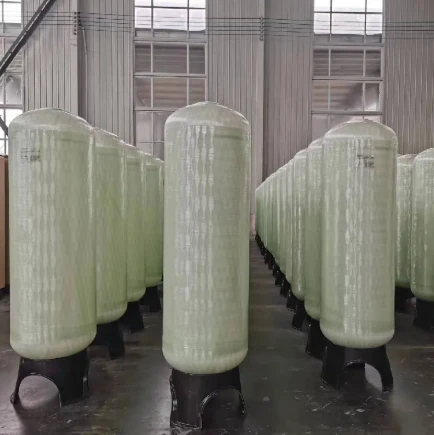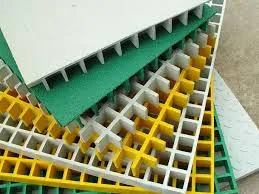loading...
- No. 9, Xingyuan South Street, Dongwaihuan Road, Zaoqiang County, Hengshui, Hebei, China
- admin@zjcomposites.com
- +86 15097380338
- Welcome to visit our website!
High Strength GFRP Grating Supplier Glass Fiber Reinforced Polymer Rod & Rebar Manufacturer
- Introduction to GFRP Grating: Materials and Core Properties
- Performance Metrics and Technical Advantages
- Global Manufacturers Comparison and Quality Assessment
- Exploring Customization Options for GFRP Structures
- Application Case Studies: Real-World GFRP Grating Implementations
- Industry Trends, Market Growth, and Future Prospects
- GFRP Grating: Summary, Recommendations, and Final Thoughts

(gfrp grating)
Introduction: An Overview of GFRP Grating and Related Composites
In the evolving landscape of structural materials, GFRP grating—alongside innovative products such as GFRP rod and glass fiber reinforced polymer (GFRP) rebar—has redefined engineering possibilities across civil, maritime, and industrial sectors. Comprised of high-strength glass fibers embedded within a polymer matrix, these composite structures offer a significant departure from conventional steel and concrete elements. Modern GFRP gratings are designed for optimal weight-to-strength ratio, endurance in corrosive environments, and exceptional durability, making them a progressive choice for both retrofitting and new construction. Understanding the base materials, the role of glass fiber orientation, and the importance of resin matrices lays the foundation for evaluating GRFP grating’s relevance in contemporary projects.
Technical Performance and Benefits in Structural Applications
The competitive edge of GFRP products emerges through their quantifiable advantages over traditional alternatives. With a tensile strength exceeding 600 MPa and a typical density ranging between 1.8-2.1 g/cm³, GFRP grating and rods are inherently lightweight. This reduces installation costs by up to 35% compared to steel, while also lowering transportation expenditures. Notably, GFRP’s resistance to electrochemical corrosion curbs the need for frequent maintenance—an attribute substantiated by a study from the American Concrete Institute which found GFRP rebars extended infrastructure life cycles by 2-3 times versus conventional rebar. Additionally, the non-conductive, non-magnetic, and non-sparking features of GFRP gratings enhance their safety profile in electrical substations, chemical processing plants, and transit track beds. The material’s low thermal conductivity also contributes to a safer, cooler working environment under direct sunlight exposure.
Manufacturer Comparison: Quality, Certification, and Service Table
Choosing the right GFRP grating or supporting components depends heavily on the credibility and innovation of leading manufacturers. Below is a comparative analysis summarizing key benchmarks.
| Manufacturer | Product Range | ISO Certification | Average Tensile Strength (MPa) | Warranty (Years) | Global Delivery | Customization Support |
|---|---|---|---|---|---|---|
| Strongwell | GFRP grating, rebar, rod | ISO 9001:2015 | 700 | 10 | Yes | High |
| Bedford Reinforced Plastics | Grating, structural shapes | ISO 9001 | 600 | 7 | Yes | Medium |
| Fibergrate | Grating, platforms, stairs | ISO 9001 | 650 | 8 | Yes | High |
| Sino Composite | Grating, rods, bars | ISO 9001, CE | 630 | 5 | Yes | Medium |
| Fiberline Composites | Profiles, grating, rods | ISO 9001, ISO 14001 | 720 | 12 | Yes | Very High |
Notably, technical consistency is paired with after-sales service, including engineering consultation for unique applications. Top manufacturers not only deliver standard GFRP grating and rod products but also invest in ongoing product testing, sustainability, and compliance with ASTM D7957 and EN 13706 standards, ensuring reliability in demanding conditions.
Custom Fabrication: Tailored Solutions for Diverse Industries
The true value of GFRP lies in its customizable properties. Modern production methods allow for adaptation of mesh size, resin type (e.g., vinylester for enhanced corrosion resistance), surface grit levels for slip resistance, and color coding. Engineers and specification writers can tailor the mechanical and chemical properties to precisely match marine, food processing, transportation, and mining requirements. For example, pultruded GFRP rods can be manufactured with epoxy resins widely used in wind turbine blades, or with polyester for cost-sensitive industrial flooring. Milling, punching, and post-fabrication coatings further enhance performance and visual appeal. Certain manufacturers offer simulation-backed design optimization for load zones, enabling lighter yet stronger grating panels for petrochemical platforms or elevated walkways. These tailored solutions reinforce operational safety, minimize downtime during installation, and support LEED credits through sustainable sourcing.
Case Studies: Transformative Implementations of GFRP Grating
Examining globally recognized projects illustrates the real-world benefits and flexibility of GFRP grating. In the Port of Rotterdam, custom-molded GFRP walkways have withstood harsh marine environments for over a decade, requiring 60% fewer replacements due to corrosion versus galvanized steel. Similarly, in the New York City Subway's station renovation, GFRP grating was employed to minimize electrical conductivity risks and streamline cable management. An Australian chemical plant reported a 40% reduction in slips and falls after switching to grit-surfaced GFRP flooring.
Further, the adoption of GFRP rods and rebars shows substantial value:
- Canadian Highway 40 Bridges: Reconstructed with GFRP rebar, they demonstrated no significant deterioration after 15 years, reducing maintenance intervals and saving $1.8 million USD in projected labor and material costs.
- Desalination Plants in the Middle East: GFRP rod inclusion in platforms led to improved chemical resistance, minimizing plant downtime from corroded supports and enhancing structural safety.
Market Insights: Growth Drivers and Future Directions
Accelerated demand for GFRP grating and related composites is evidenced by authoritative market analysis. Grand View Research projects the global GFRP market will attain a compound annual growth rate (CAGR) of 7.5% through 2030, spurred by rising infrastructure spending in Asia-Pacific and North America. The evolution of smart cities, decarbonization policies, and the escalating need for sustainable construction propel investment into lightweight, high-performance materials. Industry adoption is further driven by the expansion of energy, water treatment, and logistics facilities. Technological innovations, such as enhanced fire-retardant resins and automated pultrusion, are lowering costs and enabling high-volume, tailor-made panel production.
Additionally, life-cycle assessments indicate GFRP products emit up to 77% less greenhouse gases than galvanized steel over equivalent service lives. Government-backed green procurement standards and public-private partnerships continue to set ambitious benchmarks, forecasting a steady rise in GFRP utilization across both established and emerging markets.
Final Thoughts: GFRP Grating, Value Propositions, and Best Practices
Summarizing the insights from technical performance, global manufacturing excellence, and innovative applications, GFRP grating stands as an advanced, cost-effective, and sustainable alternative to legacy materials. Industry professionals are encouraged to carefully evaluate project specifications, adhere to international standards, and engage with manufacturers offering robust customization pathways. Selecting GFRP rods and rebar for corrosion-prone or safety-critical installations ensures longer asset life and reduced maintenance budgets.
It is recommended to partner with certified manufacturers, validate supply chains, and leverage modern simulation and analytical tools for optimal deployment. With a future focused on smarter, safer, and greener modern infrastructure, the adoption of GFRP grating continues to deliver measurable returns in both public and private sectors, underscoring its strategic importance for today's evolving construction and engineering challenges.

(gfrp grating)
FAQS on gfrp grating
Q: What is GFRP grating used for?
A: GFRP grating is commonly used for flooring, walkways, and platforms in corrosive environments. Its high strength and resistance to chemicals make it ideal for industrial applications. GFRP stands for Glass Fiber Reinforced Polymer.
Q: How does GFRP grating compare to steel grating?
A: GFRP grating is lighter, corrosion-resistant, and non-conductive compared to steel grating. It also requires less maintenance and has a longer service life in harsh environments. Steel grating, however, is stronger in terms of load-bearing capacity.
Q: What is a GFRP rod and where is it used?
A: A GFRP rod is a solid composite bar made from glass fibers and polymer resin. It is used in electrical, construction, and marine applications due to its insulating and corrosion-resistant properties. GFRP rods are often preferred over steel rods in corrosive settings.
Q: What are the benefits of glass fiber reinforced polymer (GFRP) rebar in concrete structures?
A: GFRP rebar does not corrode, making it ideal for concrete structures exposed to chemicals or moisture. It is also lighter than steel, reducing transportation and handling costs. GFRP rebar extends the lifespan of reinforced concrete structures.
Q: Are there different sizes and shapes available for GFRP grating?
A: Yes, GFRP grating comes in various sizes, thicknesses, and mesh patterns to suit diverse needs. Custom shapes can also be fabricated for specialized applications. This flexibility makes GFRP grating suitable for many industries.
-
GRP Structures: The Future of Lightweight, High-Performance EngineeringNewsJun.20,2025
-
FRP Water Tank: High-Performance Storage for Corrosive and Clean Water SystemsNewsJun.20,2025
-
FRP Square Tube: The New Industry Standard for Chemical and Structural ApplicationsNewsJun.20,2025
-
FRP Pultruded Profiles: The Ultimate Choice for Lightweight Structural StrengthNewsJun.20,2025
-
FRP Handrails: The Safer, Smarter, and Stronger Choice for Modern InfrastructureNewsJun.20,2025
-
FRP Grating: The Smart Solution for Durable, Lightweight Industrial FlooringNewsJun.20,2025
-
Why Choose a Galvanized Water Tank for Your Storage NeedsNewsMay.21,2025
